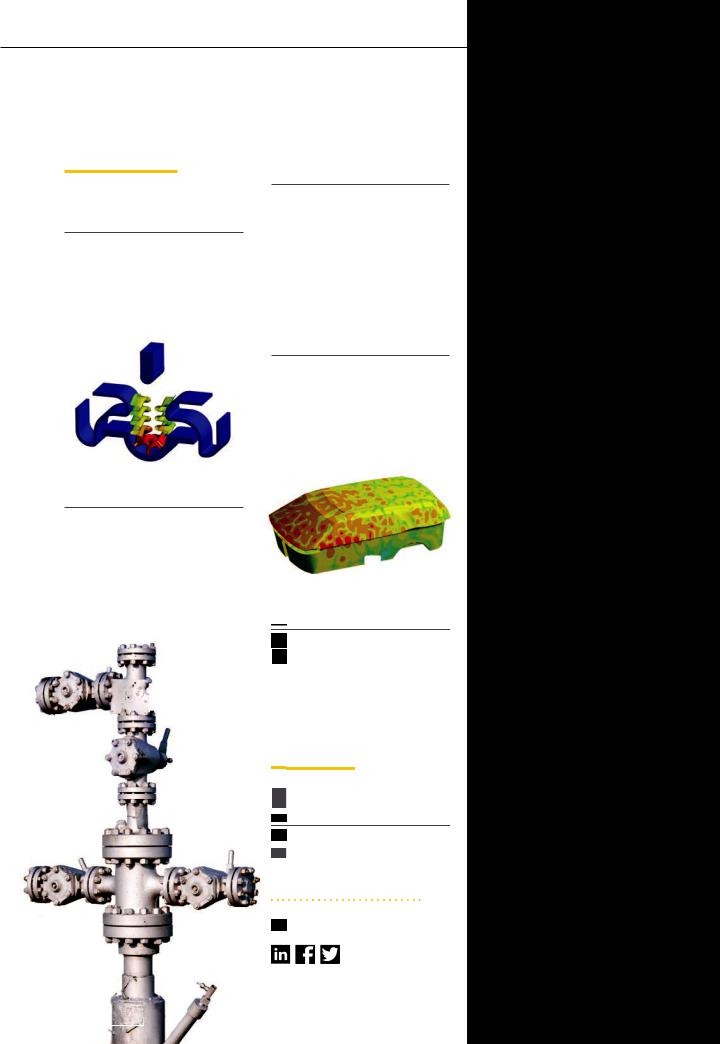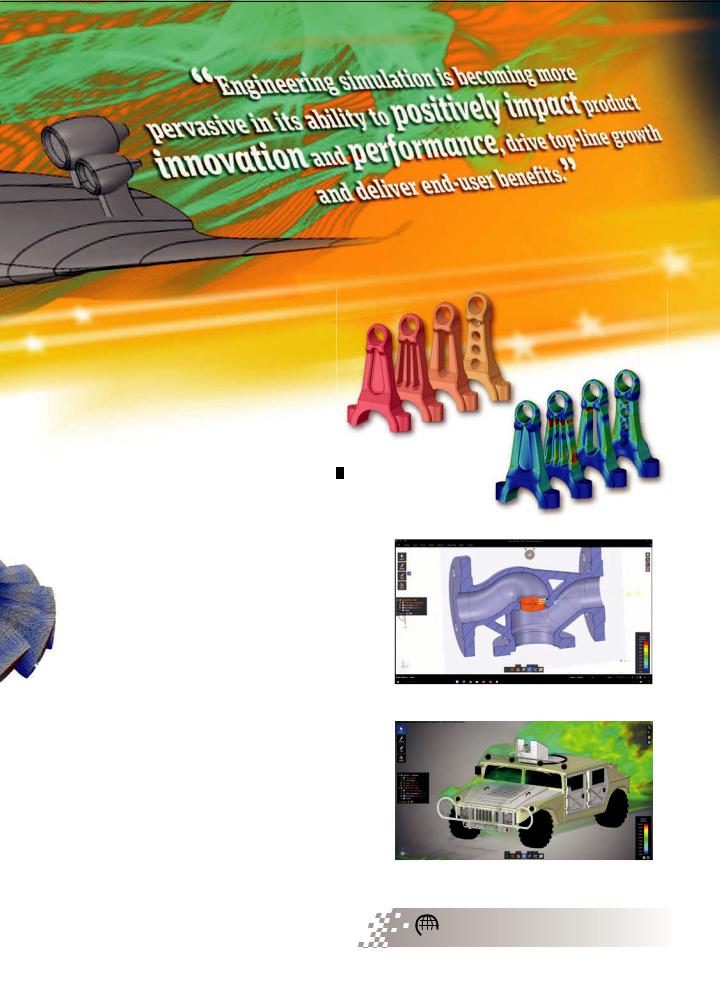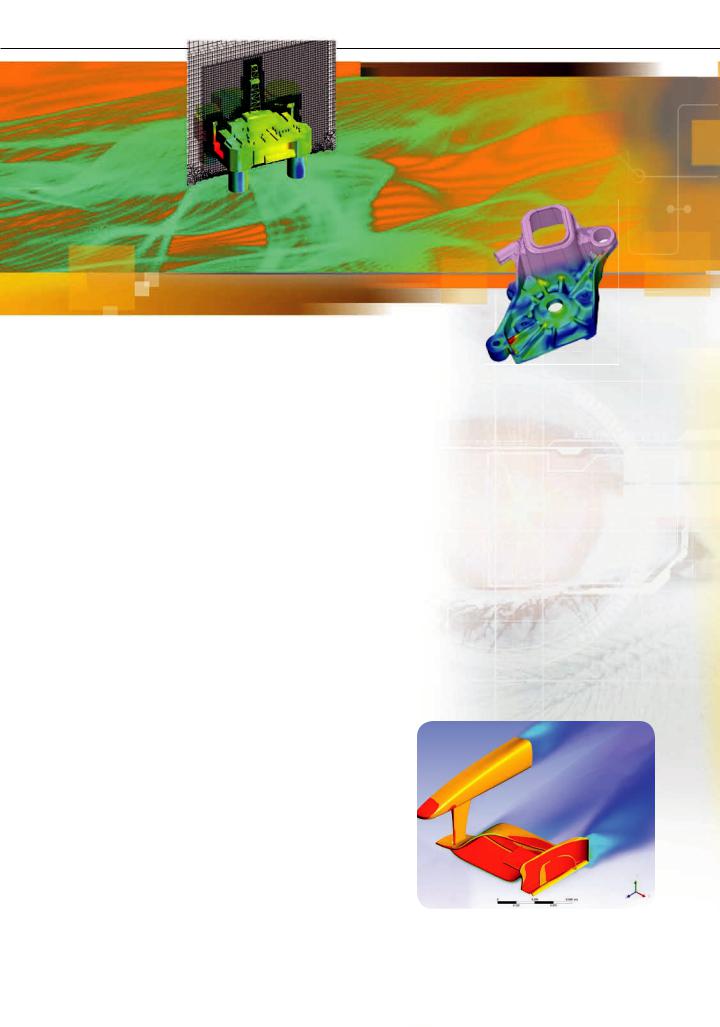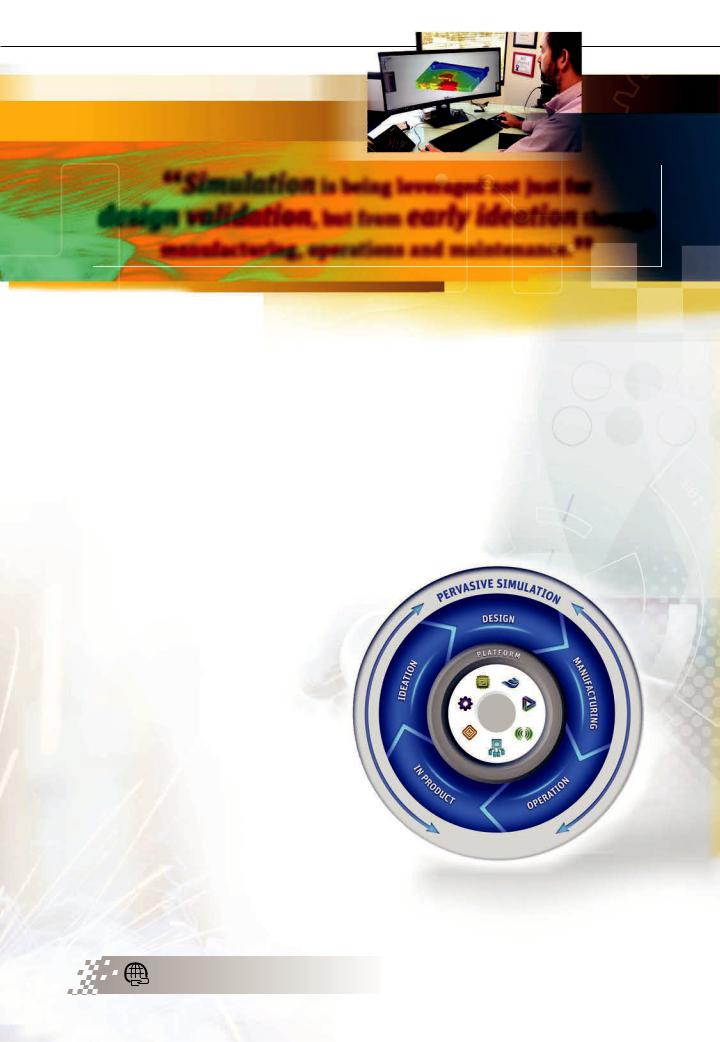
ANSYS Polyflow
.pdf
vk.com/club152685050 | vk.com/id446425943
Simulation@Work
38
MANUFACTURING
Simulation and Additive Manufacturing Speed Tooling Design
Senior Flexonics engineers validated tooling to manufacture finned tubes for a new compact liquid/air heat exchanger using ANSYS solutions.
42
AUTOMOTIVE
A Window into Automotive Noise
At Corning, engineers combined aerodynamic and vibro-acoustic analysis in ANSYS Workbench to determine how glazing can help control interior noise.
46
OIL AND GAS
Sure Footing for Onshore Drilling Sites
The time to develop new boxes to raise equipment and workers over waterlogged areas has been reduced by 90 percent.
49
OIL AND GAS
Designing Modular Wellheads
Leveraging ANSYS simulation to evaluate design alternatives for a wellhead component, WEFIC reduced development time by about 80 percent.
52
CONSTRUCTION
Up the Heat in a oftop Heating Unit
 simulation to design a rooftop
simulation to design a rooftop  ting unit that meets energy-
ting unit that meets energy-
 ciency goals saved 60 to 80 hours
ciency goals saved 60 to 80 hours  esting.
esting.
 partments
partments
mulation in the News
oundup of news items  uring simulation
uring simulation
 the simulation conversation
the simulation conversation
.com/Social@ANSYS
Welcome to ANSYS Advantage!
We hope you enjoy this issue containing articles by ANSYS customers, staff and partners. Want to be part of
a future issue? The editorial team is interested in your ideas for an article. Contact us.
The Editorial Staff, ANSYS Advantage ansys-advantage@ansys.com
Executive & Managing Editor
Chris Reeves
Editorial Advisers
Amy Pietzak, Tom Smithyman
Editorial Contributor
ANSYS Customer Excellence
North America
Senior Editor |
Designer |
Tim Palucka |
Dan Hart |
Editors |
|
Erik Ferguson |
Mark Ravenstahl |
Kara Gremillion |
Walter Scott |
Thomas Matich |
Terri Sota |
Art Directors
Ron Santillo, Dan Hart
ANSYS, Inc.
Southpointe 2600 ANSYS Drive Canonsburg, PA 15317
USA
Subscribe at ansys.com/magazine
Realize Your Product Promise®
If you’ve ever seen a rocket launch, flown on an airplane, driven a car, used a computer, touched a mobile device, crossed a bridge, or put on wearable technology, chances are you’ve used a product where ANSYS software played a critical role in its creation.
ANSYS is the global leader in engineering simulation. We help the world’s most innovative companies deliver radically better products to their customers. By offering the best and broadest portfolio of engineering simulation software, we help them solve the most complex design challenges and engineer products limited only by imagination.
ACT, AIM, Aqwa, Autodyn, BladeModeler, CFD, CFD Enterprise, CFD Flo, CFD Premium, CFX, Chemkin-Pro, Cloud Gateway, Customization Suite, DesignerRF, DesignerSI, DesignModeler, DesignSpace, DesignXplorer, Discovery Live, EKM, Electronics Desktop, Elastic Licensing, Enterprise Cloud, Engineering Knowledge Manager, EnSight, Explicit STR, Fatigue, FENSAP-ICE, FENSAP-ICE-TURBO, Fluent, Forte, Full-Wave SPICE, HFSS, High Performance Computing, HPC, HPC Parametric Pack, Icepak, Maxwell, Mechanical, Mechanical Enterprise, Mechanical Premium, Mechanical Pro, Meshing, Multiphysics, Nexxim, Optimetrics, OptiSLang, ParICs, PathFinder, Path FX, Pervasive Engineering Simulation, PExprt, Polyflow, PowerArtist, Professional, Professional NLS, Professional NLT, Q3D Extractor, RedHawk, RedHawk-SC, RedHawk-CTA, Rigid Body Dynamics, RMxprt, SCADE Architect, SCADE Display, SCADE LifeCycle, SCADE Suite, SCADE Test, SeaHawk, SeaScape, SIwave, Simplorer, Solver on Demand, SpaceClaim, SpaceClaim Direct Modeler, Structural, TGrid, Totem, TPA, TurboGrid, Workbench, Vista TF, Realize Your Product Promise, Sentinel, Simulation-Driven Product Development
ICEM CFD is a trademark licensed by ANSYS, Inc. LS-DYNA is a registered trademark of Livermore Software Technology Corporation. nCode DesignLife is a trademark of HBM nCode. All other brand, product, service, and feature names or trademarks are the property of their respective owners.
© 2018 ANSYS, INC. |
ANSYS ADVANTAGE I 3 |

vk.com/club152685050 | vk.com/id446425943
PERVASIVE ENGINEERING SIMULATION
For the products of tomorrow to become a reality, engineering simulation must change. It will evolve to be the tool for every engineer, for every product, across the entire lifecycle. Without this evolution, we will not be able to fully capitalize on the opportunities created by Industry 4.0. Those who do less will be out-innovated.
For nearly half a century, ANSYS has been instrumental in helping customers drive innovation with engineering simulation, while also reducing costs and product development time. From cars, planes and trains to consumer electronics, industrial machinery and healthcare solutions, ANSYS software has helped create products that have transformed their
respective industries.
4 I ANSYS ADVANTAGE |
ISSUE 1 | 2018 |

vk.com/club152685050 | vk.com/id446425943
While we are amazed by our customers’ achievements, we believe they represent only the beginning of the incredible value simulation can generate. Today, simulation is entering a new era, characterized by three fundamental changes:
we believe they represent only the beginning of the incredible value simulation can generate. Today, simulation is entering a new era, characterized by three fundamental changes:
•Simulation used to be a scarce resource applied in  of only the most complex industrial products, but now is becoming integral to the design of every product.
of only the most complex industrial products, but now is becoming integral to the design of every product.
•Product simulation examined single attributes: one physics, one component, one design. Now we explore a plethora of designs at the system level with interactions across multiple physical and digital domains.
•Perhaps most exciting, simulation is being leveraged not just for design validation, but from early ideation through manufacturing, operations and maintenance.
In short, engineering simulation is becoming more pervasive in its ability to positively impact product innovation and performance, drive top-line growth and deliver end-user benefits.
Because these trends are reshaping how ANSYS develops its engineering simulation software — as well as how customers worldwide, in every industry, leverage our solutions — it is worth considering each of these changes in more detail.
A SIMPLE PRODUCT? NO SUCH THING
When engineering simulation debuted in 1970, it represented a novel capability — but one that required highly skilled
engineering specialists to set up, as well as computing resources only available to the very largest organizations. As a result,
it was almost exclusively applied to the most complex and costly engineered products, such as industrial machinery, cars and aircraft.
Pervasive Simulation for a Digital World  ansys.com/pervasive-world
ansys.com/pervasive-world
© 2018 ANSYS, INC. |
ANSYS ADVANTAGE I 5 |

vk.com/club152685050 | vk.com/id446425943
Simulation Redefined (continued)
“The digital revolution is happening in every
industry and for every product.”
However, in 2018, there is no such thing as a simple product. Today, every design is being pushed to the limit to take advantage of composite materials, additive manufacturing and the high level of connectivity and automation enabled by Industry 4.0. The result is a new generation of smart, durable and sustainable products.
You might believe that engineering macro trends are only disrupting products such as cars, by increasing electrification and autonomy. However, this digital revolution is happening in every industry and for every product. Simulation is
essential in this new world, because only by digitally simulating all the product options offered by these engineering trends can you gain the insight needed to
innovate like the category leaders. Today we see customers such as Mars, which makes Skittles® candy,
use ANSYS software to optimize its manufacturing processes by leveraging the same simulation sophistication as turbine manufacturers. And startup Nebia used the same equations that
govern rocket exhaust to save 70 percent of water consumption in a showerhead.
No product is too small, simple or inexpensive to benefit from simulation.
COMPLEX ANALYSIS FOR A COMPLEX WORLD
As we push for ever-smarter and more efficient product designs, we can no longer afford to only look at a single aspect of performance or a lone part in isolation. In the past, engineering simulation teams were likely to isolate just one critical physics — for
instance, Formula 1 carmakers might have focused on the vehicle’s aerodynamics, which has a profound impact on speed and performance.
Today, thanks to improvements in simulation software, hardware and processing speeds, it has become much easier for engineers to study multiple physics and assess overall product performance. This is critical because, to use the Formula 1 example, overall speed and performance do not only
6 I ANSYS ADVANTAGE |
ISSUE 1 | 2018 |

vk.com/club152685050 | vk.com/id446425943
depend on aerodynamics. The efficiency of combustion, the ability of the tires to withstand wear, the reliability of electronics — all of these factors, and more,
affect overall performance. Because optimization in one area might lead to a trade-off in another, it becomes increasingly important to simulate all influences together. Today, 96 of ANSYS’s top 100 customers worldwide use three or more physics solutions, applied across the ANSYS platform.
Improvements in computing power and simulation software also allow the evaluation of many more design options, to the point where the design process can be turned upside down. Rather than asking simulation to verify a specific design, engineers are asking simulation to analyze thousands of possible designs, early in the ideation process, to identify the optimal one. This is perhaps most obvious in
“Soon, leveraging engineering simulation
pervasively will no longer be just a competitive advantage
of the few, but an absolute imperative for all.”
topology optimization, where the engineer sets up, for example, the structural criteria for a part and simulation automatically iterates to find the best design.
Increasingly, simulation will start from the requirements and generate the design, instead of being applied after most of the design choices have been made. This is the only way to tame the complexity inherent in modern product design, and to capitalize on the opportunities created by the rapid innovation required to be successful today.
GENERATING RETURNS ACROSS THE PRODUCT LIFECYCLE
Probably the most important change today is a more pervasive, consistent use of simulation at all stages of a product’s lifecycle. Once a specialized activity wedged between initial design and physical testing, today simulation is recognized for the significant strategic value and financial returns it can deliver from the earliest design phases through the product’s working life in the field.
Even today, the majority of product decisions are made using rules of thumb, and simulation is primarily used by specialists within
© 2018 ANSYS, INC. |
ANSYS ADVANTAGE I 7 |

vk.com/club152685050 | vk.com/id446425943
Simulation Redefined (continued)
the engineering team. Others still rely on the most used engineering tool, which is Microsoft® Excel. As simulation advances to become as easy and as fast to use as Excel, this opens a whole new era of innovation, in which every engineer can benefit from detailed simulation insights at any time sign process. When products are in the earliest ideation stage, designers xploration to test their initial concepts and gain insights that lead to
targeted at meeting highly defined customer needs, as well as earning
strong profit margins.
In a world where millions of rows of data are updated, calculated and charted in real time in Excel, and where Google gives us immediate access to billions of websites, it is almost incomprehensible that simulation is not equally accessible to every engineer. At ANSYS, we are making breakthroughs with Discovery Live and other products to make this a reality. In a few years, it will be unimaginable to innovate without native and pervasive use of simulation by every engineer.
Simulation is also increasingly applied to the manufacturing phase, where it significantly improves the efficiency, costeffectiveness and flexibility of production. With the rise of mass customization of products — made possible by additive
manufacturing, or 3D printing
— simulation helps ensure that the finished product has the optimal shape and is made accurately, costeffectively and with a high degree of consistency over time.
Additive manufacturing might enable us to produce almost any imaginable shape, but which is optimal? Can the human mind even conceive of the optimal shape? And, with mass customization, how do we ensure that every variation still preserves product integrity and performance? Simulation is key to unlocking the potential of 3D printing on a large scale by making
it easy for companies to analyze on-demand and answer these questions to deliver unique, reliable, high-quality products with an extraordinary degree of confidence.
As the product moves from design and manufacturing into operations, simulation can continue to play a pivotal role in delivering the
8 I ANSYS ADVANTAGE |
ISSUE 1 | 2018 |

vk.com/club152685050 | vk.com/id446425943
“Simulation is being leveraged not just for
design validation, but from early ideation through
manufacturing, operations and maintenance.”
best possible results in the field. By using remote sensors to gather data on a product’s working conditions, analysts create a virtual replica — a digital twin — of that product and then apply the same physical forces and other environmental conditions to the digital model. Applying simulation as part of a digital twin can provide vital insights in the form of virtual sensors, in situations where no physical sensor exists or would even be possible. Simulation also can run what-if studies for optimal performance, and can predict critical failure or maintenance requirements.
Digital twins are in their infancy today, but as Industry 4.0 matures, they will become increasingly commonplace, running on demand either in the cloud or on the asset itself. Increasingly, simulation will become an in-product experience in which the digital twin is an inherent part of the product’s design and operation, working alongside artificial intelligence and machine
learning algorithms.
PERVASIVE SIMULATION: THE NEW IMPERATIVE
While not all companies are applying simulation to every product, studying the effects of multiple physics or leveraging simulation throughout the entire product lifecycle, these three trends signal the future. Leaders are already employing these best practices. Soon, leveraging engineering simulation pervasively will no longer be just a competitive advantage of the few, but
an absolute imperative for all.
Ongoing improvements in simulation software make it easier than ever for a broad range of users throughout a business to apply these best practices. If you are currently using simulation only in your product
development function, or only on certain designs, you are failing to realize the full potential of ANSYS software
to deliver strategic and financial benefits for your business. When engineering simulation software made its debut nearly
50 years ago, early adopters quickly distinguished themselves from those companies who were slower to recognize and embrace its potential. Tomorrow, it will be part of the toolbox for every engineer.
Realize Your Product Promise ansys.com/innovation
© 2018 ANSYS, INC. |
ANSYS ADVANTAGE I 9 |

vk.com/club152685050 | vk.com/id446425943
BEST PRACTICES
Navigating
Toward
Full Autonomy
For many years, cars and aircraft have featured some degree of assisted or partial autonomous functionality that we have trusted, whether an autopilot or an advanced driver assistance system (ADAS) such as blind spot detection. Today, time to market is of the essence, and the race is on to achieve full
autonomy. This represents a step change in both engineering complexity and applicable safety criteria. Since conducting road-testing over the billions of miles required to demonstrate safety is timeand cost-prohibitive, companies have turned to simulation as the only way to successfully complete an autonomous vehicle program.
10 I ANSYS ADVANTAGE |
ISSUE 1 | 2018 |

vk.com/club152685050 | vk.com/id446425943
Autonomous vehicles are proliferating, and not just in the automotive market. Companies like Amazon are investing heavily in drone delivery capabilities, while military organizations have utilized drone technology in combat situations for years. Manufacturers are using mobile autonomous robots in their production
facilities, while transportation companies are developing tractor trailers that can run 24 hours a day, moving goods across thousands of miles quickly and cost-effectively. There is little doubt that autonomous vehicles are in our near future as consumers. However, getting there presents significant technology challenges for us as engineering professionals.
Semiconductor
Simulation
Software and
Algorithm
Development
Functional |
|
|
|
Safety Analysis |
|
|
Sensor |
|
|
|
Simulation |
|
|
|
|
|
Electronics and |
||
|
Hardware Simulation |
||
|
|
|
Critical technologies for autonomous vehicles |
There are good reasons to be excited about this trend. Autonomous vehicles and drone delivery promise
to practically eliminate the element of human error, which caused 94 percent of the record-high 37,461 highway accidents that occurred in 2016.[1][2] As the degree of autonomy increases, the probability of human error declines significantly. Fully autonomous vehicles, supported by artificial intelligence and neural network algorithms, will enjoy a continuous 360-degree view of their surroundings — and those algorithms will never take a break to text their friends.
If we can replace flawed human behavior with fail-safe autonomous control — while consolidating our transportation investments — it only makes sense to pursue full autonomy for cars, drones and other machines. However, before this can happen within the bounds of engineering certainty, a number of technology challenges must still be solved.
It has been estimated that demonstrating the safety of an autonomous vehicle could take over
8 billion miles of physical road testing.[3] In the race to achieve full autonomy, this is simply not practical. At the current rate of progress, road testing would take centuries to complete.
Engineering simulation is the answer, as it enables autonomous vehicles to be tested and verified in a risk-free, low-cost, time-efficient virtual environment. A recent safety report from Waymo — formerly the Google self-driving car project — described how its engineers are simulating the performance of a fleet of 25,000 virtual self-driving cars across more than
8 million road miles every day.[4]
Fast-Tracking Autonomous Vehicles, Drones and Robots Via Engineering Simulation ansys.com/autonomy
© 2018 ANSYS, INC. |
ANSYS ADVANTAGE I 11 |

vk.com/club152685050 | vk.com/id446425943
Navigating Toward Full Autonomy (continued)
“Engineering simulation is the answer, as it enables autonomous vehicles to be tested and verified in a
risk-free, low-cost, time-efficient virtual environment.”
Demonstrating Safety Through Closed-Loop Simulation
At the highest level, these simulations must be able to capture the behavior of the vehicle in its environment. This can be characterized as a closed-loop simulation of the vehicle as it “sees,” “thinks” and “acts,” guided by artificial intelligence. The simulation includes virtual cities and roads, the sensors that function as the
eyes and ears of the vehicle, the control software and algorithms that make critical decisions, and the vehicle dynamics, which are based on
the instructions received from the software and algorithms. This simulation represents a continuous, closed-loop process through time, as the vehicle senses, executes and maneuvers through its journey.
Of course, these closedloop simulations can only be considered reliable
if they contain accurate representations of all the relevant components of the
vehicle and its surroundings. There are five critical engineering capabilities that support an accurate virtual road-testing exercise:
•Sensor design based on the real-world conditions they must perform in
•Semiconductor optimization that balances high performance with risks such
as electronics density and thermal build-up
•Reliable electronics designed to withstand actual operating environments
•Safety-critical embedded software development that integrates with machine learning and artificial intelligence components
•Functional safety analysis that minimizes the risks associated with component-
or system-level failure
Each of these critical engineering applications is discussed as follows.
Reliable Sensors for Real-World Perception
Sensors are the eyes and ears of any autonomous vehicle, and thus are some of its most critical components. They are also among the most complex, tasked with gathering and processing large volumes of environmental data in real time and communicating this data to a perception algorithm. Common sensor types for autonomous vehicles include radar, lidar, cameras and ultrasound.
Testing and verifying the performance of the sensors represents a significant engineering challenge. For example, radar sensors are typically mounted behind the front fascia of an automobile. While perfectly controlled physical testing environments, such as anechoic chambers, can help engineers design these systems, the reality is that their radiation patterns will be skewed in real-world
applications by the material properties and geometric configuration of a car’s front fascia. To operate predictably and reliably on the road, radar systems must be designed to operate behind the front fascia of dozens of different types of vehicles, each with its
own unique geometry and material properties. Physical building and testing is simply not practical due to the time and costs involved in each design iteration.
ANSYS offers a full suite of radar and antenna simulation solutions designed to replicate real-world performance with
a high degree of fidelity. By leveraging ANSYS software, electrical engineers can predict sensor performance accurately
— whether the sensor system is studied independently,
mounted on a vehicle, placed into a static environment or studied throughout a fast-moving closed-loop simulation.
12 I ANSYS ADVANTAGE |
ISSUE 1 | 2018 |
